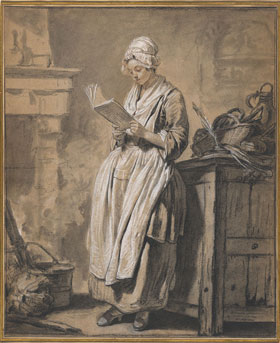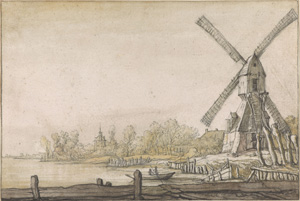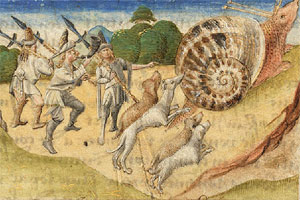A Taste for Collecting
John Haberin New York City
The Eveillard and Moore Gifts to the Morgan
The Book of Marvels: Imagining the Medieval World
Say what you will about the Elizabeth and Jean-Marie Eveillard collection: the collectors have taste.
No doubt they must if they are to go about their self-appointed task, but they have good taste in museums, too. They had the taste to contribute to the Frick Collection, which displayed their gift just last year. Now they continue as donors to another of New York's most treasured enclaves. The gift brings just over two dozen drawings to the Morgan Library from the Baroque through early Modernism.  If it is a touch tasteful, you will understand. Just do not mistake a welcome plainness and discipline for merely good taste.
If it is a touch tasteful, you will understand. Just do not mistake a welcome plainness and discipline for merely good taste.
It was Christmas in July at the Morgan. No sooner did the small lobby gallery open with the Eveillard gift of drawings from several restless centuries than Santa was back in town. Eighty drawings from the Clement C. Moore collection are a promised gift—but more on him and Santa in a moment. It offers a chance to assess just what the great age of Dutch art meant for the Dutch. It may not be a compendium of stellar names and stellar prints, but that seems only right for an emerging nation. It suggests a collective enterprise tied up in the Dutch republic while reaching across Europe with its influence.
If one thing comes to mind about the Middle Ages, it could well be stasis. What could disturb centuries of ritual, art, and ideas? What could disturb the darkness? With The Book of Marvels, the Morgan traces not just the end of an era, but something more. In reality, the world itself was changing, and travelers were catching up with the changing picture. As the show's subtitle has it, they were "Imagining the Medieval World," and they invite you to imagine it as well.
Plainness and discipline
Those who caught the Eveillard gift at the Frick will know it all but exclusively for decorative art. That suited an institution in its temporary quarters on Madison Avenue, with separate rooms for decorative art. What, then, should one expect for J. P. Morgan's domain as himself a collector? Would the drawings run once more to excess or rather to another side of the decorative arts—academicism in place of experiment. In the end, sobriety wins out, and it need not be all that tasteful. It illuminates how much study goes into seemingly wilder art.
Peter Paul Rubens brings his usual sweeping gestures and creative excess to a biblical scene, with alternative compositions that collide on a single sheet on their way into the sky. Something of his musculature and movement appears as well in John the Baptist by a lesser artist, Tanzio da Varallo, around 1620. What, then, should one make of a seated woman in a sober dress by Juan Gris, without a trace of Cubist fragmentation? Tired of the repetition and contortions in sculpture by Auguste Rodin? Here a female nude lies asleep. The composition follows that of a standing nude regardless, with her head above her feet, and a second pair of legs show the artist finding his way and bringing her awake.
Artists, then, had work to do on their way to paintings and prints. Some never get all that far, and the show has its share of minor names and failures. Rembrandt focuses on an emotionally and morally laden moment, Judas returning the thirty pieces of silver, but it is less than memorable. Others, though, revel in restraint. Antoine Watteau often does, while inventing Rococo lightness, but what of Romanticism and Théodore Géricault? Soon after The Raft of the Medusa, with its the heroics on the verge of death, he sketched ordinary workers unloading a cart.
As with Géricault, plain and simple may be in service of sympathy with those that art might easily have left out. Paul Signac poses his grandfather, mother, and maid for The Dining Rome. Eugène Delacroix tones down the action for his caretaker, Guercino for a Moor. Paul Gauguin abandons his mythic women for a Tahitian child. Jean-Baptiste Greuze dispenses for once with his moralism for a cook reading. The engraver who received the drawing called her a thief, but she looks absorbed in her work and her imagination.
More often still, artists worked from studies because that is what they do. John Constable takes care for layers of landscape, but Pierre-Auguste Renoir in watercolor can linger on a handful of clouds or trees, too. Jacob Jordaens in the Baroque and Georges Seurat in Post-Impressionism alike show standing figures from behind, in full weight. Those who know his drawings will know how much his art depends on the discipline of Conte crayon in black and white. For Edgar Degas, every painting is akin to a study, here with wild horses rather than dancers. For Paul Cézanne, the interplay of experiment and experience is the essence of art.
There have been better drawings and more ambitious exhibitions. The Eveillard gift to the Frick already had me thinking of how much finer it will with the Frick mansion as context for art. Still, it gets at the space between experiment and experience. A dreamer by Odilon Redon from 1898 surrenders herself to her dream, but seems so still that she could be looking inward or observing the sky. A swash of white could be an emblem of surrender, a bird, or a cloud. She is of a piece with the readers and observers in work to every side.
A visit from the Dutch
Clement C. Moore no doubt descends from Clement Clarke Moore, although the Morgan does not say so. It must wish him to stand on his own as a scholar and now donor. The older Moore, of course, wrote "A Visit from Saint Nicholas," about "the night before Christmas," and that seems right, too. No one did more to convert a religious holiday to a secular one—and a gift to all mankind to a bag of toys for children. (Trust me, a Jew who benefited.) And no nation did more to assert a secular purpose for art.
It stays all the truer to that purpose in drawings. In The Hundred Guilder Print (nicknamed for its one-timer cost and extravagance), Rembrandt shows Jesus preaching, healing the sick, and reaching out to all. A quick sketch isolates a sick woman and a still more haunting face. The poor really will always be with us. A boy from Adriaen van de Velde, who could easily be their companion, catches what rest he can leaning on the jug that must have helped put him to sleep and given him what small pleasures he could claim. The angel of the Annunciation for Samuel van Hoogstraten seems to have dropped by just to say hello.
 The show opens with Mannerism in the late 1500s, to show the emergence of a new art and a new century, although dates jump wildly back and forth. It has an alcove for what a past show at the Morgan (also with work from Moore) called "Rembrandt's World," but with more of his school than the man itself. It cares more for results than for chronology or artist, in an arrangement largely by subject. That includes France and Italy, where Cornelis van Poelenburch found inspiration for Dutch landscape in towering, glistening rocks. It includes close observation of butterflies and tulips, with none of the moralizing in still life as fresh but dying for Flemish artists of the time. It includes the Flemish themselves, like Jordaens, Peter Paul Rubens, and Anthony van Dyck.
The show opens with Mannerism in the late 1500s, to show the emergence of a new art and a new century, although dates jump wildly back and forth. It has an alcove for what a past show at the Morgan (also with work from Moore) called "Rembrandt's World," but with more of his school than the man itself. It cares more for results than for chronology or artist, in an arrangement largely by subject. That includes France and Italy, where Cornelis van Poelenburch found inspiration for Dutch landscape in towering, glistening rocks. It includes close observation of butterflies and tulips, with none of the moralizing in still life as fresh but dying for Flemish artists of the time. It includes the Flemish themselves, like Jordaens, Peter Paul Rubens, and Anthony van Dyck.
Mostly, though, it describes a land and a people. It unfolds during their long war of independence from Spain, but without a battle in sight. The royal fleet puts on a panorama, but not half so memorably as fishermen for Hendrick Avercamp, a lone man crossing a bridge for Guercino (an Italian), or the banks of a stream for Jacob van Ruisdael. A Roman general comes home to a public welcome, but it could be just another village festival. And gatherings are everywhere, only not so easy to tell from chance encounters and private outings. Hendrick Goltzius fills a sheet with nudes, as prelude to painted myth. They might have gathered for an afternoon in the sun.
Individuals come off as smart, casual, and vulnerable, with not a touch of Flemish bravura. A man from Peter Levy, quite possibly himself, might be dreaming or showing off. He also shares his dignity with herdsmen for Paulus Potter and Jan Lievens, who also supply the herd. The nation was built on their collective labor. It was built, too, on wind power, but windmills are just one landmark in a layered landscape. Aelbert Cuyp uses lighter strokes in chalk to deepen and distinguish the layers.
You can, if you like, tease out how he and others constructed a world. Esaias van de Velde replaces the aerial perspective of Harvesters for Pieter Bruegel with a close view. Moore has continued to collect past the Baroque, too, and a postscript carries him through Thomas Gainsborough, John Constable, and J. M. W. Turner with their greater confidence and drama. Then again, you can stick with the spirit of a plainer art. When Vincent van der Vinne sketches the Grote Kerk in Haarlem, he leaves family emblems on pillars at peculiar angles. The might show a lesser artist at work, human neglect, or the ravages of war.
O Brave New World
The Book of Marvels contained many discoveries, and so did the medieval journeys that preceded it. The Morgan does not stop with that one book, not even in the small gallery off the atrium. A modern marvel itself on its hundredth birthday, the museum holds the travels of Marco Polo to the East and Christopher Columbus—who published his own account of, he still believed, a shorter passage to India. It has the legend of John Mandeville, an almost surely fictitious Englishman, that may have first appeared in French. They witnessed men with six arms or two heads and bearded women. They found Asian spices, fabrics, teas, and the entirety of Islam. 
O brave new world that has such people in 't. So goes a memorable line from Shakespeare's The Tempest, from a girl whose discoveries, of flawed and altogether normal people, came by sea to her. As her father replies, chastening, 'Tis new to thee. But then it is only a fiction, and so are the claims with which I began. Far from static, the Middle Ages had its philosophical changes, as Aristotle gave way to original sin, and its political ones, as Rome lost its dominance. It strayed from home for the Crusades to the Holy Land. Trade routes to the Middle East and Asia were opening up as well.
The show's premise is suspect as well, although interesting. The travels of Alexander the Great and Pliny belong to the ancient world, not the medieval one, and The Book of Marvels, from the 1460s, or The Book of Nature, from 1475, to the Renaissance. Columbus obviously wrote after 1492—and not about India after all, but rather a true brave new world, the Americas. And will it be about the day-to-day world that men and women knew or about imagined marvels? If it has mostly anonymous artists without the true wonders of illuminated manuscripts and medieval bibles, it has the interest of actual lives, hunting and exploring. Someone had to push against the limits of the medieval world.
Just this past fall, the Met staked its tale of the early Renaissance on Duccio in Siena, at the center of new trade routes. Where would a curator stake a career, after all, without a contrarian's history? The Morgan's curator, Joshua O'Driscoll, has his fictions as well, but also insights. He grounds the show in both ways of discovering one's own world, imagining and mapping. In different ways, they create and reflect the hierarchy of late Middle Ages and its giving way to something new. Already the appreciation of marvels suggests the advent of science, trade, and an openness to discovery.
The imaginings are themselves anything but the European church triumphant. The most vivid colors come with black African skin and Persian Islamic art. The many nudes are neither demurely shrouded nor Renaissance heroes. At the same time, a hierarchy appears in depicted wealth and architecture. Those nudes arrange themselves frontally in a several story building. They know where they belong.
Maps may seem more like historical curiosities than art, but they are just as revealing. A guide to the Crusades looks like a treasure map. Later ones show a closed world, but a world that contains multitudes. An encompassing sea forms the picture's borders. It may consciously invert the ancient view bounded by the shores of the Mediterranean, as in the Odyssey. It may be a brave new world after all.

The Eveillard collection ran at The Morgan Library through October 6, 2024, the Clement C. Moore collection through September 22. "The Book of Marvels" ran through May 25, 2025.




